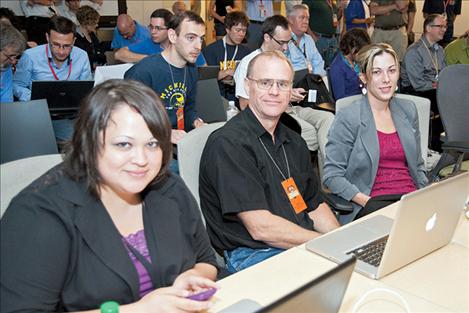SKC professor, students part of Mars Rover team
Hey savvy news reader! Thanks for choosing local.
You are now reading
2 of 3 free articles.
PABLO — Mars, the red planet, and Western Montana are literally worlds apart, but Dr. Tim Olson, a Salish Kootenai College physics professor, and two of his students, Noel Stewart, Browning, and Judy Hudgins, Ronan, are helping bridge the gap. They are at the National Aeronautic and Space Administration Jet Propulsion Laboratory in Pasadena, Calif.
In an email interview, Olson explained that he has been working on preparations for this mission since 2004 as one team member among many. Olson said he and the students are members of the Mars Science Laboratory Science Team of about 400 people.
“Most specifically, we’re members of the MAHLI/MARDI/Mastcam camera science team, about two dozen people,” Olson said.
As science team members, Olson said he and his two students contribute to deciding what data to collect, help with scientific interpretation of the data and write scientific papers describing the interpretation of the data.
On the camera team, Olson, Stewart and Hudgins assist the science team in designing observations that use the cameras and “command the cameras to make observations.”
They spend about half a day on each team.
The SKC team will be in California for the first 90 days of rover operations, until Nov. 3.
After that the science team members will all go back home and participate in the project back in Montana.
“The work day can start at any time of the day on Earth,” Olson said, “since we are staying in sync with the Martian day for the first 90 days of surface operations.”
Since a day on Mars is 39 minutes longer than an Earth day, the workday moves an average of 39 minutes later each day. Between receiving the Rover data from the previous day and sending commands up for the next day, the workday is about 16 hours long.
Commands are sent directly to the Rover from earth, Olson explained. Data from the Rover is relayed through the two U.S. spacecraft that are orbiting Mars (the Mars Reconnaissance Orbiter and the Mars Odyssey.)
“The preparations have had several aspects: advising NASA on the selection of the landing site, developing procedures for operating the cameras, training on camera operations, and training on working as science team members. Hudgins has been working mainly as a payload downlink lead for the MAHLI, MARDI and Mastcam cameras. This involves receiving data from the cameras, getting the images into viewable formats and placing the imagery on NASA servers for access by the science team and the general public. She also takes note of what specific images are received, and any that weren’t received that should have been, so these images can be retransmitted from the rover.
Stewart also has been working as a payload uplink lead for the MAHLI, MARDI and Mastcam cameras. In this role, she works with the science team members to help them plan the images they want to take with the cameras. She communicates the details of this desired imagery to the staff that write the camera commands for the Rover.
The main goal of the mission is to assess whether Mars has ever been habitable for microbial life. The science instruments selected for the mission were picked to provide data that can potentially answer that question.
Early in its history, Mars was likely more Earth-like, Olson said, with a thicker atmosphere that kept the surface warm enough to have liquid water on its surface.
Evidence of this is seen in landforms that appear to have been caused by rivers and lakes and certain types of minerals that form on Earth in the presence of liquid water.
The Gale Crater landing site has these minerals and may at one time been filled by a lake. Lakebeds on earth preserve a record of life in the form of the organic compounds trapped within the mud.
















